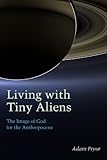Living with Tiny Aliens : The Image of God for the Anthropocene / Adam Pryor.
Material type: TextSeries: Groundworks: Ecological Issues in Philosophy and TheologyPublisher: New York, NY : Fordham University Press, [2020]Copyright date: ©2020Description: 1 online resource (240 p.)Content type:
TextSeries: Groundworks: Ecological Issues in Philosophy and TheologyPublisher: New York, NY : Fordham University Press, [2020]Copyright date: ©2020Description: 1 online resource (240 p.)Content type: - 9780823288335
- Exobiology -- Religious aspects
- Image of God
- Theological anthropology
- Religion
- Science Studies
- Theology
- RELIGION / Christian Theology / Anthropology
- Anthropocene
- Astrobiology
- David Grinspoon
- Karen Barad
- Maurice Merleau-Ponty
- flesh
- habitability
- image of God
- imago Dei
- intra-action
- play
- presence
- wonder
- online - DeGruyter
| Item type | Current library | Call number | URL | Status | Notes | Barcode | |
|---|---|---|---|---|---|---|---|
 eBook
eBook
|
Biblioteca "Angelicum" Pont. Univ. S.Tommaso d'Aquino Nuvola online | online - DeGruyter (Browse shelf(Opens below)) | Online access | Not for loan (Accesso limitato) | Accesso per gli utenti autorizzati / Access for authorized users | (dgr)9780823288335 |
Browsing Biblioteca "Angelicum" Pont. Univ. S.Tommaso d'Aquino shelves, Shelving location: Nuvola online Close shelf browser (Hides shelf browser)

|

|

|

|

|

|

|
||
| online - DeGruyter The Fact of Resonance : Modernist Acoustics and Narrative Form / | online - DeGruyter Against Sustainability : Reading Nineteenth-Century America in the Age of Climate Crisis / | online - DeGruyter Radical Ambivalence : Race in Flannery O'Connor / | online - DeGruyter Living with Tiny Aliens : The Image of God for the Anthropocene / | online - DeGruyter Working Alternatives : American and Catholic Experiments in Work and Economy / | online - DeGruyter Uniquely Okinawan : Determining Identity During the U.S. Wartime Occupation / | online - DeGruyter Middling Romanticism : Reading in the Gaps, from Kant to Ashbery / |
Frontmatter -- Contents -- Introduction: Being in Outer Space -- 1. Exoplanets and Icy Moons and Mars, Oh My! -- 2. Astrobiology's Intra-Active Aliens -- 3. Being a Living-System -- 4. The imago Dei as a Refractive Symbol -- 5. Conceptualizing Nature -- 6. The Anthropocene as Planetarity in Deep Time -- 7. An Artful Planet -- 8. Living-Into Presence, Wonder, and Play -- Epilogue: Ad Astra Per Aspera -- Acknowledgments -- Notes -- Bibliography -- Index
restricted access online access with authorization star
http://purl.org/coar/access_right/c_16ec
Astrobiology is changing how we understand meaningful human existence. Living with Tiny Aliens seeks to imagine how an individuals' meaningful existence persists when we are planetary creatures situated in deep time-not only on a blue planet burgeoning with life, but in a cosmos pregnant with living-possibilities. In doing so, it works to articulate an astrobiological humanities.Working with a series of specific examples drawn from the study of extraterrestrial life, doctrinal reflection on the imago Dei, and reflections on the Anthropocene, Pryor reframes how human beings meaningfully dwell in the world and belong to it. To take seriously the geological significance of human agency is to understand the Earth as not only a living planet but an artful one. Consequently, Pryor reframes the imago Dei, rendering it a planetary system that opens up new possibilities for the flourishing of all creation by fostering technobiogeochemical cycles not subject to runaway, positive feedback. Such an account ensures the imago Dei is not something any one of us possesses, but that it is a symbol for what we live into together as a species in intra-action with the wider habitable environment.
Mode of access: Internet via World Wide Web.
In English.
Description based on online resource; title from PDF title page (publisher's Web site, viewed 02. Mrz 2022)


